
A digital single-lens reflex camera is a digital camera that combines the optics and mechanisms of a single-lens reflex camera with a solid-state image sensor and digitally records the images from the sensor.

A mirrorless camera is a digital camera which, in contrast to DSLRs, does not use a mirror in order to ensure that the image presented to the photographer through the viewfinder is identical to that taken by the camera. They have come to replace DSLRs, which have historically dominated interchangeable lens cameras. Other terms include electronic viewfinder interchangeable lens (EVIL) cameras and compact system cameras (CSCs).

The Fujifilm X series is a line of digital cameras produced by Fujifilm. The series encompasses fixed lens and interchangeable lens mirrorless cameras and premium compact point-and-shoot cameras aimed at consumer, enthusiast and professional photographers. The X series is part of the larger FinePix range of digital cameras from Fujifilm.

The Fujifilm X-Pro1 is a mirrorless interchangeable-lens digital camera announced in January 2012 and launched in March 2012. It is part of Fujifilm's X-Series of cameras. In October 2012 Fujifilm released a very similar, yet smaller, camera named the X-E1. In January 2016 Fujifilm announced its successor, the X-Pro2.
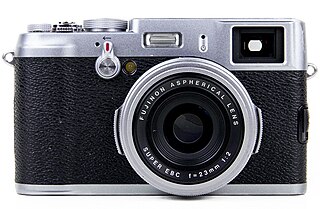
The Fujifilm X100 is a series of digital compact cameras with a fixed prime lens. Originally part of the FinePix line, then becoming a member of the X series from Fujifilm, the X100 series includes the FinePix X100, X100S, X100T, X100F, X100V, and X100VI. They each have a large image sensor and a 23 mm lens. All six cameras have received generally positive reviews.
In Sony digital cameras, the acronym ILCE stands for "Interchangeable Lens Camera with E-mount". In August 2013, Sony announced the first model of the ILCE mirrorless camera with E-mount, electronic viewfinder, contrast-detection autofocus and Multi Interface Shoe, the ILCE-3000. In October 2013, two full-frame E-mount cameras were announced, the ILCE-7 and ILCE-7R.

The Fujifilm X-E2 is a digital rangefinder-style mirrorless camera announced by Fujifilm on October 18, 2013. An updated version with minor improvements of the camera, called the Fujifilm X-E2s, was announced on January 15, 2016. Both cameras are part of the company's X-series range of cameras.
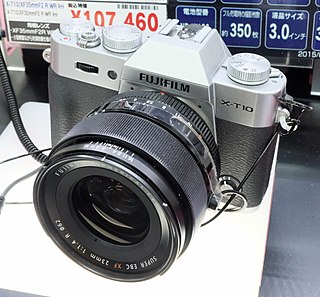
The Fujifilm X-T10 is a digital interchangeable-lens camera announced by Fujifilm on May 18, 2015. It is a smaller, lighter and lower priced alternative to the Fujifilm X-T1, Fujifilm's flagship camera. The camera was made available in an all black colour scheme, in addition to a silver and black colour scheme.
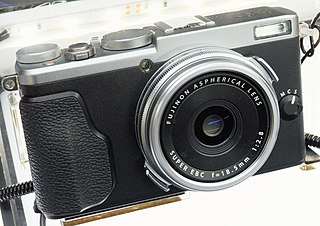
The Fujifilm X70 is an APS-C sensor digital compact camera with an 18.5 mm fixed prime lens. It is part of Fujifilm's X-Series of cameras. It was announced in January 2016 and was released on 18 February 2016.

The Fujifilm X-Trans is a sensor developed by Fujifilm and used in its Fujifilm X series cameras. Unlike most sensors featuring a conventional Bayer filter array, X-Trans sensors have a unique 6 by 6 pattern of photosites. Fujifilm claims that this layout can minimise moiré effects, and in turn increase resolution by eliminating the need for a low-pass filter.

The Fujifilm X-T20 is a mirrorless interchangeable-lens camera announced by Fujifilm on January 19, 2017. The X-T20 is a successor to the X-T10, which was released in 2015, with a number of iterative refinements and enhancements over it.

The Nikon Z 7 is a 45.7 megapixel full-frame mirrorless interchangeable-lens camera produced by Nikon. The camera was officially announced on August 23, 2018, for release in September 2018. It was the first camera to use Nikon's new Z-mount system; the second model, released in November 2018, was the 24.5 megapixel Nikon Z 6.

The Fujifilm X-T3 is a mirrorless interchangeable-lens digital camera announced on September 6, 2018. It is weather-resistant, has a backside-illuminated X-Trans CMOS 4 APS-C sensor and an X-Processor 4 quad core processor. It is the successor to 2016's Fujifilm X-T2. It uses the Fujifilm X-mount.

The Sony α6400 is a digital camera announced on January 15, 2019. It is an APS-C mirrorless interchangeable lens camera (MILC) designed to be a mid-range mirrorless camera and acts as the successor to the α6300. Intended to target the vlogging community, the α6400 features a flip-up screen and aggressive pricing. It features the same 24 megapixel sensor seen in the α6500. At the time of release, the two most capable cameras in the α6000 series of cameras were the α6400 and the α6500. The α6500 features in-body image stabilization and a larger image buffer, but the α6400 is arguably more advanced as the newer model. This is largely due to its increased processing power, real-time eye AF, and real-time tracking. These features, for example, can not be added to the α6300 via a firmware update, as it would be too demanding on the processor.
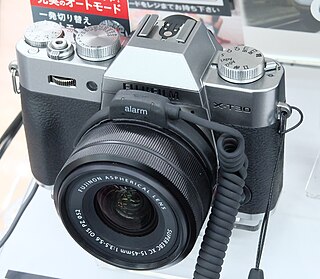
The Fujifilm X-T30 is a mirrorless interchangeable-lens camera announced by Fujifilm on February 14, 2019. The X-T30 is a successor to the X-T20, which was released in 2017. It is sold in three finishes: black, silver and charcoal silver.

The Canon EOS M6 Mark II is a digital mirrorless interchangeable-lens camera announced by Canon on August 28, 2019, and released in September 2019. As with all of the Canon EOS M series cameras, the Canon EOS M6 Mark II uses the Canon EF-M lens mount. The M6 Mark II is the successor of both the M5 (2016) and the M6 (2017).

The Fujifilm X-T4 is a mirrorless interchangeable-lens digital camera announced on February 25, 2020. It has a backside-illuminated X-Trans CMOS 4 APS-C sensor and an X-Processor 4 quad core processor and uses the Fujifilm X-mount. The X-T4 is a weather-resistant camera equipped with a higher-capacity battery designed to last longer than the X-T3. It is the successor to 2018's X-T3, which is a little smaller and lighter.

The Fujifilm X-S10 is a mid-range mirrorless interchangeable-lens camera announced on October 15, 2020. It has a backside-illuminated X-Trans CMOS 4 APS-C sensor, an X-Processor 4 quad core processor, In-Body Image Stabilization(IBIS) and uses the Fujifilm X-mount. The X-S10 is proposed as a hybrid camera aimed at still photographers, video shooters and vloggers, given its vlogger friendly features. It bears little relation to the Fujifilm X-S1 bridge camera released in 2011.
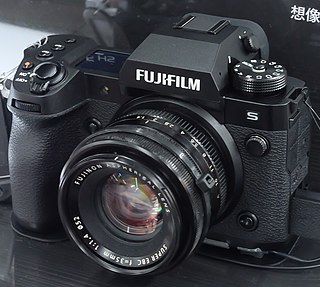
Fujifilm X-H2S is a 26-megapixel mirrorless camera produced by Fujifilm. The X-H2S, which will be positioned as more similar to a pro DSLR than anything else in the X-series, is the company's latest high-speed flagship model. It is the successor of the X-H1 from 2018 and will be available for $2,499 on July 7, 2022.

The Fujifilm X-T5 is a mirrorless interchangeable-lens digital camera announced on November 2, 2022. It is the successor to 2020's X-T4 with improved autofocus, higher resolution and reduced body size. The 40.2 megapixels X-Trans 5 sensor is the highest-resolution APS-C sensor currently on the market.





















